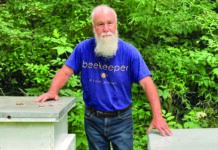Mark Twain once famously said, “Whiskey is for drinking, water is for fighting over.” Recently, Reps. Yadira Caraveo, D-CO, and Jake LaTurner, R-KS, jointly introduced the bipartisan Voluntary Groundwater Conservation Act in the House of Representatives that should reduce fighting over water.
The goal, says the bill’s supporters, is for it to become part of the farm bill. U.S. Sens. Jerry Moran, R-KS, Michael Bennet, D-CO, and Martin Heinrich, D-NM, introduced the Voluntary Groundwater Conservation Act in the Senate earlier in July.
The act “gives farmers and ranchers the flexibility they need to protect groundwater sources while also keeping their agricultural lands in production under a new voluntary groundwater easement program at the United States Department of Agriculture’s Natural Resource Conservation Service within the Agricultural Conservation Easements Program,” according to statements by both members.
The Voluntary Groundwater Conservation Act would:
- Create a new Groundwater Conservation Easement Program at USDA to encourage voluntary, compensated reductions in groundwater consumption on agricultural land and advance local, regional, or state groundwater management goals;
- Allow NRCS to reimburse transaction costs up to 5% of the federal share and requires an advance payment for limited resource producers to cover these costs;
- Guarantee “long-term management flexibility for a producer to continue farming and choose how they reduce their water use, as long as they conserve the amount they’ve committed to reducing each year;”
- Ensure that farmers are “fairly compensated using a payment based on the market value for the water right instead of a per acre payment;” and
- Clarify that easement funds shall not be counted toward a farm’s adjusted gross income and that producers with an adjusted gross income of more than $900,000 are eligible for a waiver from the secretary of agriculture to participate in groundwater conservation easements.
The bill is supported by a number of farm and ag organizations, including the Colorado Farm Bureau. Zach Riley, executive director of the Colorado Livestock Association, said that while his group doesn’t officially oppose the bill, he is “wary of a federal pathway to potentially control [state-regulated] groundwater.”
Water use and transfer rights are largely regulated by the states, rather than the federal government. Unlike water quality, which is regulated by the federal Clean Water Act. Each state has a differently layered mix of water rights, using a variety of legal doctrines about water use. In Colorado water rights are like property rights that can be bought and sold. When water rights are sold and agriculture stops on the land it’s called Agricultural Water Transfer, more commonly known as “buy and dry.”
But according to its supporters, the bill is largely a fix of existing federal programs created in the last farm bill, a fix that benefits producers and gives them more flexibility. That bill—the 2018 Agriculture Improvement Act—authorized the secretary of agriculture to incentivize partnerships to conserve water, including making payments to producers to voluntarily curtail use of water rights.
Jesse Bradley, deputy director of natural resources for the Nebraska Department of Natural Resources, said he hasn’t seen the proposed bill and couldn’t comment on it directly. But he explained that under the USDA’s Conservation Reserve Enhancement Program, producers who participate are encouraged to let water-abated land return to grassland.
Under the proposed bill, landowners would be allowed to practice dryland production or grazing on the land, as long as they don’t use their water rights. “We [in Nebraska] have been having some of these conversations about water and land use with our counterparts in Colorado,” Bradley told High Plains Journal.
Bradley said the current approach to voluntarily curtailing water rights yokes together two distinct purposes: conserving water and restoring land to a “natural” state. But those two purposes need not always go together, and one doesn’t automatically imply the other.
The Inflation Reduction Act provides $4.6 billion to the Bureau of Reclamation—part of the Department of the Interior—designed in part to compensate water users who agree to water use reductions in voluntary water conservation agreements. That came on the heels of the Infrastructure Investment and Jobs Act’s $8.3 billion in emergency supplemental appropriations for reclamation, in equal installments from FY2022 to FY2026.
This funding is available to entities like cities, water districts and tribes within the 17 “reclamation states” named in the Reclamation Act of 1902 including Arizona, California, Colorado, Idaho, Kansas, Montana, Nebraska Nevada, New Mexico, North Dakota, Oklahoma, Oregon, South Dakota, Utah, Washington and Wyoming; parts of Texas were later added.
The Caraveo-LaTurner bill comes on the heels of the recently announced Colorado River water pact reported on by HPJ at bit.ly/45lOfJb. Under that deal, the Department of the Interior announced an agreement among seven Western states to voluntarily reduce their allocated water rights in exchange for short-term payments while infrastructure projects to address Colorado River shortages longer-term are being completed.
Payments to water users, including farmers, totaling about $1.2 billion, will come from the IRA, to be divided among water districts, cities and tribes that reduce their water usage. Arizona, California and New Mexico agreed to conserve at least an additional 3 million acre feet of Colorado River water in the lower basin by the end of calendar year 2026, with at least 1.5 MAF of that total being conserved by the end of calendar year 2024. That amount is about 13% of the three states’ total allotment.
In an era of climate volatility, droughts and increasing demand on aquifers, everyone agrees that voluntary conservation agreements have a big role to play in our water future. Making them easier and more attractive for farmers to participate in is a win for everyone. Whether or not they will be enough to preserve and sustain shrinking aquifers remains to be seen.
As reported in the High Plains Journal.




